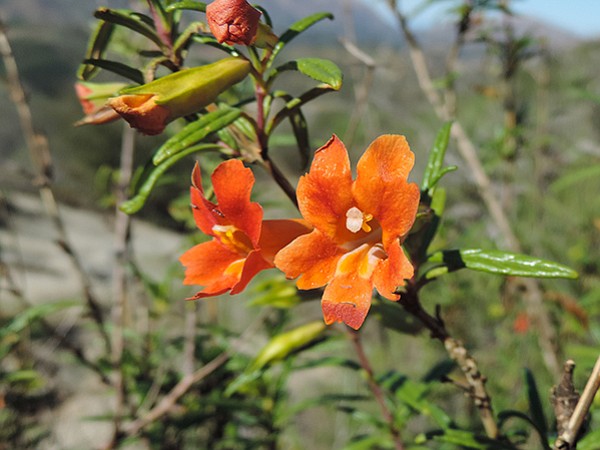 Facebook
Facebook
 X
X
 Instagram
Instagram
 TikTok
TikTok
 Youtube
Youtube

Monkey-Flowers of various species are putting on an excellent display this month around San Diego. Look for these low, shrublike plants with tubular yellow, orange, or red flowers wherever native vegetation clothes the landscape — from the coastal bluffs to the lower slopes of the mountains. As you drive Interstate 8 or 805 near Mission Valley, look for the rust tint these flowers give to the steep hillsides. On the terraces just above San Onofre State Beach, you can usually see springtime monkey-flower blossoms of every intermediate shade from yellow to red.
Desert Agaves, or century plants, are sending up their asparaguslike flower stalks on rocky hillsides throughout much of the Anza-Borrego Desert. On warm, sunny days the stalks may grow almost one foot per day (fast enough for you to notice the sharp leaf tips at the bud actually separating from one another). After the stalk reaches a height of 10-20 feet, clusters of waxy, yellow flowers appear, ready for pollination by bees and other insects. After blooming, the fleshy, dagger-like leaves at the base of the plant die (after a life of 10 or 20 years, not a century), and the stalk, bearing a crop of seeds, dries up as well.


Monkey-Flowers of various species are putting on an excellent display this month around San Diego. Look for these low, shrublike plants with tubular yellow, orange, or red flowers wherever native vegetation clothes the landscape — from the coastal bluffs to the lower slopes of the mountains. As you drive Interstate 8 or 805 near Mission Valley, look for the rust tint these flowers give to the steep hillsides. On the terraces just above San Onofre State Beach, you can usually see springtime monkey-flower blossoms of every intermediate shade from yellow to red.
Desert Agaves, or century plants, are sending up their asparaguslike flower stalks on rocky hillsides throughout much of the Anza-Borrego Desert. On warm, sunny days the stalks may grow almost one foot per day (fast enough for you to notice the sharp leaf tips at the bud actually separating from one another). After the stalk reaches a height of 10-20 feet, clusters of waxy, yellow flowers appear, ready for pollination by bees and other insects. After blooming, the fleshy, dagger-like leaves at the base of the plant die (after a life of 10 or 20 years, not a century), and the stalk, bearing a crop of seeds, dries up as well.
Comments